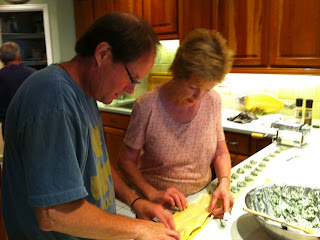The shape of ravioli can be obtained in a few different ways. One way is to place the filling on one pasta sheet, overlapping the next, and then separating the ravioli by cutting the squares around the pasta pockets; or they can be done by cutting pasta sheets in rounds (we used the top of a round glass), placing the filling in the center and topping the ravioli with another pasta round to form a circle. The fillings vary from vegetables like spinach, mushrooms, squash, etc..to different kinds of meat, cheese, or even seafood. Ravioli are boiled and then dressed in many different ways, you can use a mixture of butter and herbs as a sauce or my preference is a marinara sauce topped with freshly grated parmigiano reggiano cheese. Serve with a good, crusty, French baguette and Sara's classic Caesar salad, the family's favorite.
Sara's Caesar Salad
Sara's Caesar Salad
Sara had a great tip in suggesting these will likely hold their shape better if they're frozen prior to cooking. Plus, it will help ease the burden of this very long process by preparing this in 2 days instead of 1.
For the filling:
1 lb fresh spinach
1 lb ricotta cheese, thoroughly drained
1 egg
4 oz parmigiano reggiano cheese, freshly grated
salt and pepper
pinch of nutmeg
For the dough:
3 cups flour
4 eggs
water
4 TBSP fresh basil, minced
4 TBSP fresh parsley, minced
1 TBSP extra-virgin olive oil
For a butter and herb sauce (optional):
4 oz unsalted butter
10 fresh sage leaves
4 oz freshly grated parmigiano cheese
Boil the spinach in lightly salted water. Place the boiled spinach in a cheese cloth and form a small sack. Squeeze the sack to expel as much water as possible. Chop the spinach finely.
Place the spinach in a bowl. Combine the drained ricotta, egg, parmigiano cheese, salt, pepper, and a generous pinch of nutmeg. Taste and adjust the salt, pepper, and nutmeg if necessary.
Prepare the pasta dough by sifting the flour and mixing each egg in individually as you go. Mix in the fresh herbs. Use just enough water to make the dough very soft and moist. Use the minimum flour necessary, just enough to prevent the dough from sticking to your hands while working. Cut the dough in two parts. Place one of the pieces on the work surface, and flatten it with a rolling pin until it is very thin. Or, of course you can use a pasta machine as we did to flatten the balls of pasta. Repeat the same steps with the other half of the dough, making a pasta sheet of the same size. Set it aside on wax paper, covered with a moist towel if necessary to prevent the pasta from drying too much.
Place about 1 tsp of the filling on the dough, spaced 2 inches apart.
Separate the ravioli by cutting with a pastry wheel or pizza cutter. We found it easier to use little round formations of pasta that we cut out with the top of a glass and then added 1 tsp of the filling. Either method crimp the edges with a fork.
If making the butter herb sauce, use a skillet large enough to contain the ravioli, place the butter and sage leaves. Turn the heat on just long enough to melt the butter. Set aside.
Bring water to a boil in a stockpot with a touch of olive oil. Gently drop the ravioli in the boiling water a few at a time.
Cook until the pasta is al dente (firm but not too soft or overcooked). Drain the ravioli, picking them from the boiling water with a slotted spoon.
If making the butter herb sauce, use a skillet large enough to contain the ravioli, place the butter and sage leaves. Turn the heat on just long enough to melt the butter. Set aside.
Bring water to a boil in a stockpot with a touch of olive oil. Gently drop the ravioli in the boiling water a few at a time.
Cook until the pasta is al dente (firm but not too soft or overcooked). Drain the ravioli, picking them from the boiling water with a slotted spoon.
Transfer the ravioli to the pan. Stir gently until they are evenly coated with the butter or marinara sauce. Place in a warm serving dish, top with some grated cheese and serve at once.












No comments:
Post a Comment